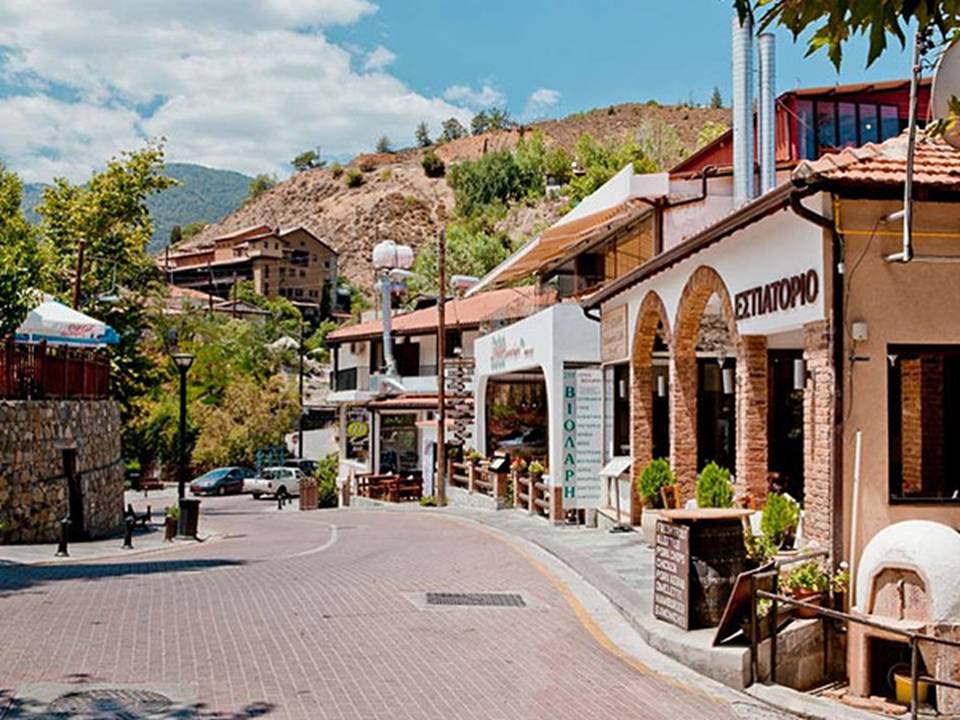The Picturesque Village of Kakopetria
Nestled in the heart of the Troodos Mountains, Kakopetria village stands as one of Cyprus's most picturesque and historically rich villages. With a name that translates to “bad stone” in Greek, Kakopetria’s history and culture captivate every traveller who wanders through its cobbled streets. Its scenic beauty, unique architecture, and vibrant cultural life make it an unforgettable gem that invites visitors to experience a blend of traditional life and nature’s wonders.
Ancient Roots and the “Bad Stone” Legend
Kakopetria’s origins trace back to ancient times, and while no one knows the exact date of its founding, local legends and archaeological evidence suggest its existence stretches far into the past. The name “Kakopetria” tells an interesting tale rooted in myth and legend. According to one popular story, a massive boulder in the village had a curse, harming any couple who crossed its path. Over the years, the legend of the “bad stone” persisted, adding an air of mystery to the village and eventually inspiring its unique name. The boulder still sits along the riverbanks today, silently bearing witness to centuries of tales and superstitions.
Traditional Architecture and Village Charm
Kakopetria’s architecture reflects the simple yet charming designs typical of Cypriot mountain villages. Narrow, winding streets weave through clusters of two-story stone houses. Residents built these homes with thick walls and wooden balconies that overhang the streets below. The houses' mudbrick construction helps them stay cool in the hot summers and retain warmth during chilly winters. Many homes feature tiled

roofs and wooden beams, creating a rustic aesthetic that aligns harmoniously with the surrounding landscape.
Central to Kakopetria's architectural allure is the Old Village, known as “Palia Kakopetria.” This preserved area retains its historic structures, allowing visitors to step back in time and witness the Cypriot lifestyle from centuries past. People can stroll along cobbled alleys, passing by vine-covered walls, ancient olive presses, and fountains that once provided the village with fresh mountain water. Artisans and craftsmen still populate this area, adding to its lively and authentic atmosphere.
Natural Beauty and the River Klarios
Kakopetria enjoys a prime location between two rivers, the Karkotis and Garillis, which merge to form the Klarios River. The village flourishes because of these rivers, which provide water for the lush vegetation that surrounds it. Large plane trees, fruit orchards, and fragrant pines grow abundantly, casting shade over pathways and offering cool respite in the summer months.
Nature trails wind along the riverbanks, leading travellers through scenic landscapes filled with diverse flora and fauna. Birdsong fills the air as hikers make their way to nearby spots like the Platania Forest, a haven for nature lovers. The forest lies only a short walk from the village and offers picnic spots, hiking paths, and glimpses of native Cypriot wildlife. In the fall, the area becomes a tapestry of red, orange, and gold as leaves change colour, creating a spectacle that draws photographers and nature enthusiasts from across the island.

Byzantine Churches and Religious Heritage
Religion has always played a significant role in Kakopetria’s history, and the village proudly preserves this heritage. The church of Saint Nicholas of the Roof stands as one of the most notable religious sites in the area. Constructed in the 11th century, this Byzantine church boasts beautiful frescoes that depict biblical scenes in vivid colours. The church's unusual name comes from its double-pitched roof, which early villagers added to protect the frescoes from rain damage. Today, Saint Nicholas of the Roof attracts art lovers, history buffs, and pilgrims alike, eager to witness its ancient beauty and spiritual significance.
Another important religious landmark is the Church of the Holy Cross, located in the village centre. The church dates back to the 14th century and houses intricate wood carvings and a gilded iconostasis that reflect traditional Cypriot religious artistry. Villagers still gather here for celebrations, making it a lively hub of community life.
Celebrations and Local Culture
Kakopetria’s residents preserve their traditions and customs through colourful festivals and celebrations held throughout the year. The grape harvest in the fall brings one of the most anticipated events, where villagers gather to press grapes and produce wine and Zivania, a local spirit. Music, dance, and feasting fill the village square during these festivities, embodying the vibrant Cypriot spirit and hospitality.
The village also celebrates Easter with passion and

enthusiasm. People gather in the main square for processions, music, and the sharing of traditional foods like flaounes (a cheese-filled pastry). These gatherings offer a unique opportunity for visitors to experience Cypriot culture firsthand and to see the warmth and joy that define village life.
Kakopetria Today
Kakopetria has evolved over the years, welcoming modern conveniences without sacrificing its traditional identity. Small guesthouses, cosy cafes, and restaurants offer visitors comfort while maintaining a close connection to local heritage. Many visitors come to Kakopetria to escape the bustling cities and immerse themselves in the tranquillity of rural life. Local businesses, run by villagers, pride themselves on their hospitality and authentic offerings, from homemade sweets to handwoven textiles.
The village serves as a living testament to Cypriot history, where ancient myths, scenic beauty, and a warm community come together to create an unforgettable destination. Travellers can wander through history, explore stunning natural landscapes, and share in traditions that have stood the test of time.


